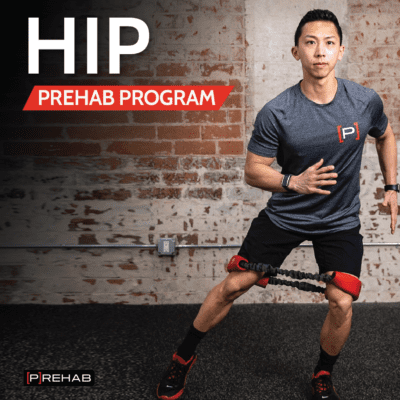The gluteus medius or glute med for short is a muscle on the lateral portion of the hip that is crucial for a variety of activities of daily living. When we try to perform higher-level activities like weight lifting and sports activities, this muscle becomes even more important! Why? The glute med is so important because it is vital to our ability to stabilize ourselves during single leg balance. While we might not realize it, we live on 1 leg a lot. Walking, for instance, is the act of repeatedly balancing on a single leg over and over again. Strengthening the glute med can also help to resolve hip pain, low back pain, and even pain at your knee or foot! This article will take a closer look at what the glute med does as well as some of the best exercises for training this muscle.
What is the Glute Med?
The glute med is a muscle on the side of the body that extends from the top of the pelvis (the iliac crest) across the hip joint to the top of the femur on the greater trochanter. As you can see from the picture below – working this muscle will pull your leg outward into a position called abduction.

Image courtesy of Learn Muscles
However when your leg is on the ground, as it is during single leg activities like walking, this muscle functions to stabilize the pelvis on the hip and prevent your hip from hiking upward. This is known as a Trendelenburg gait or hip drop (described by the dropping of the opposite side of your hip, rather than the hip hiking on the standing leg). Thus, as we spend a lot more time walking than we do reaching our leg out to the side, the primary function of this muscle is to stabilize our hips to maintain what is referred to as a “neutral pelvis”. As you can imagine, the demands on your glute med during higher-level activities such as running, cutting, and jumping are much greater.
Maximize Glute Med Engagement and Overall Hip Health!
It’s all in the hips! This program will bulletproof your entire hip complex, which creates a foundation for your entire lower leg, and also helps with your pelvic and back health!
So how do we train the Glute Med?
We have already established that the glute med muscle is primarily a hip abductor that will lift your leg outward away from your body. More importantly, this muscle will maintain your hips in a neutral position when your foot is planted on the ground. Thus, the glute med can be trained through any variation of these 2 motions. Some common exercises for targeting the glute med include:
- Clamshells
- Sidelying Hip Abduction
- Lateral Band Walks
- Squats with a band
- Bridge with a band
How Do We Assess An Exercise?
With all the different options, it can sometimes feel difficult to pick the best exercise to target your glute med. Fortunately, there has been a great deal of research in this area. A number of studies have used electromyography (EMG) to evaluate the activation produced in a muscle while performing a given exercise. To assess how well an exercise targets a muscle researchers must first establish an MVIC or “Maximal Voluntary Isometric Contraction” which represents the maximum amount of force a muscle can generate when performing its motion against resistance. Researchers can then compare the force generated during a given exercise to its maximum and express that force as a percentage of MVIC.
LISTEN: TALKING GLUTES WITH BRET CONTRERAS
So which glute med exercises are the best?
Thus the best exercise for the glute med would be one that generates a force of 100% MVIC. However, any exercise that generates greater than 70% MVIC would be considered an excellent glute med exercise. Researchers in 2009 compared 12 different exercises in 21 healthy subjects to evaluate the best exercises for the glute med. These exercises included:
- Sidelying hip abduction
- Clamshells at varying degrees
- Single Leg Squat
- Single Leg Deadlift
- Lunge variations
- Hop variations
- Lateral walks with a band
They found that sidelying hip abduction was the best of these exercises for the glute med producing 81% MVIC. This was followed by the single limb squat (64% MVIC). Surprisingly, the traditional clamshell exercise had less than 40% MVIC.
Watch This Video To Learn The Secrets To Building Stronger Glutes
Sidelying Hip Abduction
Sample Hip [P]Rehab Program Exercise Video
- HOW: Begin on your side with your leg on top straightened out. Elevate the top leg towards the ceiling and back wall simultaneously. Avoid crunching at your low back or rotating your body open towards the ceiling.
- FEEL: You should feel the outer hip, particularly the glute muscles with this exercise. You can place your top hand on your pelvis to assure the motion is coming from the hip and not the lower back.
- COMPENSATION: Avoid rotating your entire trunk or performing a side crunch with this exercise. Make sure the shoulder that is facing the ceiling stay in front of the shoulder that is against the floor.
Single Leg Squat
Having a box behind you is a great way to start working on the single leg squat. If this is too challenging, try it supported!
READ: Exercises To Fix Your Trendelenburg Gait
Supported Single Leg Squat
Sample Hip [P]rehab Program Exercise Video
Using equipment like the TRX can help you with the single leg squat if you are lacking stability and/or adequate strength to perform this movement unsupported. No worries if you do not have access to the TRX! Use any object, such as a wall or chair to hold onto. Focus on putting as much weight and load through your leg as possible and as little load through your upper body that is needed to ensure you are working that glute med as well as the rest of the lower extremity to its maximum!
The Prehab membership is the anti-barrier solution to keeping your body healthy. Access state-of-the-art physical therapy, fitness programs, and workouts online in the comforts of your own home or gym! Taking control of your health with exercise & education from the palm of your hand has never been easier. Get access to 50+ programs, 100+ unique workouts, and 3000+ exercises to build your own workout routines. Trial it for free, and learn how to get out of pain, avoid injury, and optimize your health with [P]rehab!
Is there anything better?
While this was an excellent study, a more comprehensive study analyzing 22 different exercises was performed in 2011. This study examined many of the exercises in the previous study but also included a variety of higher-level exercises such as side planks with hip abduction. These researchers actually found that the side plank with hip abduction was the best exercise for recruiting the glute med, reaching a level of 103% MVIC in the leg that is on the ground. Furthermore, side plank with hip abduction was also the 2nd best exercise for the glute med when analyzing the leg that is lifted into abduction (88% MVIC).
Best Exercises For The Glute Med
Side Plank – Hip Abduction
Learn more side plank progressions HERE!
The 2011 study allowed increased depth for the single leg squat as compared to the study published in 2009. This crucial difference led to a higher level of glute med activation during the single leg squat in this study than the sidelying hip abduction. Additionally, this study included clamshell variations such as the reverse clamshell which was shown to have greater glute med activation than the sidelying hip abduction exercise.
Clam – Internal Rotation
Sample Hip [P]Rehab Program Exercise Video
The graph below outlines the top exercises for glute med activation that were found in this study.
Glute Med Activation Based On Specific Exercises

From Boren et. al
But, what about clamshells?
It is worth noting the exercises listed as hip clam 4 and hip clam 3 are both clamshell variations with hip internal rotation as shown in the video above. As you can see the traditional clamshell (Hip Clam 1) only generated 47% MVIC of the glute med. This is consistent with the earlier study mentioned.
However, while the traditional clamshell may not be the best exercise for the glute med, it has been shown to be the best exercise for preferentially activating the glute max and glute med while minimizing the activation of the Tensor Fascia Latae or TFL. This is often a priority during rehab as utilization of the TFL over the glutes has been shown to contribute to altered lower extremity mechanics in a pathological lower extremity. Thus, while the clamshell exercise may not be best for your glute med, it certainly still has its place in rehab!
Level Up Your Clams!
Closing thoughts
- The side plank with Hip Abduction is THE BEST exercise for activating the glute med
- This exercise should be performed on both sides as it benefits each leg differently.
- The clamshell with internal rotation and the sidelying hip abduction exercise is better for activating the glute med than the traditional clamshell
- The traditional clamshell is the best exercise for activating the glute max and glute med while minimizing the activation of the TFL.
Take Control of Your Hip Health!
It’s all in the hips! Okay, maybe not ALL but in most activities the hips are the main driver of movement. The surrounding hip musculature provides stability and force production for walking, lunging, single leg stance, and squatting patterns. It’s a unique design that requires mobility, stability, strength, and power. If mobility and stability become compromised discomfort becomes the result. In this program, you learn to take control and earn back meaningful activity by improving hip mobility, stability, and strength, or a better way to put it: function!
References
- Distefano LJ, Blackburn JT, Marshall SW, Padua DA. Gluteal muscle activation during common therapeutic exercises. J Orthop Sports Phys Ther. 2009;39(7):532-540. doi:10.2519/jospt.2009.2796
- Boren K, Conrey C, Le Coguic J, Paprocki L, Voight M, Robinson TK. Electromyographic analysis of gluteus medius and gluteus maximus during rehabilitation exercises. Int J Sports Phys Ther. 2011;6(3):206-223.
- Bishop BN, Greenstein J, Etnoyer-Slaski JL, Sterling H, Topp R. Electromyographic Analysis of Gluteus Maximus, Gluteus Medius, and Tensor Fascia Latae During Therapeutic Exercises With and Without Elastic Resistance. Int J Sports Phys Ther. 2018;13(4):668-675.





